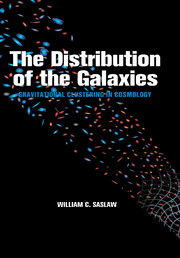Book contents
- Frontmatter
- Contents
- Prologue
- Part I Historical
- Part II Descriptions of Clustering
- Part III Gravity and Correlation Functions
- Part IV Gravity and Distribution Functions
- Part V Computer Experiments for Distribution Functions
- Part VI Observations of Distribution Functions
- 33 Observed Spatial Distribution Functions
- 34 Observed Peculiar Velocity Distribution Functions
- 35 Observed Evolution of Distribution Functions
- Part VII Future Unfoldings
- Bibliography
- Index
34 - Observed Peculiar Velocity Distribution Functions
Published online by Cambridge University Press: 19 January 2010
- Frontmatter
- Contents
- Prologue
- Part I Historical
- Part II Descriptions of Clustering
- Part III Gravity and Correlation Functions
- Part IV Gravity and Distribution Functions
- Part V Computer Experiments for Distribution Functions
- Part VI Observations of Distribution Functions
- 33 Observed Spatial Distribution Functions
- 34 Observed Peculiar Velocity Distribution Functions
- 35 Observed Evolution of Distribution Functions
- Part VII Future Unfoldings
- Bibliography
- Index
Summary
no one can bottle a breeze
AudenVelocities are the current frontier, as spectrographs with fiber optic cameras scramble to produce larger catalogs. Some galaxies will have good secondary distance indicators and be useful for peculiar velocities. Catalogs whose peculiar velocities are homogeneously sampled can provide direct comparisons with theoretical predictions.
So far, most catalogs of peculiar velocities are for restricted samples such as spirals in clusters, or for isolated field galaxies. This again involves finding a suitable definition of a cluster or field galaxy. Relating convenient morphological definitions of clusters to the underlying physics of their formation is often quite difficult. It is simpler, and perhaps less model dependent, to consider the combined peculiar velocity distribution for all clustering scales and degrees from isolated field galaxies and small groups to the richest dense clusters. The corresponding predictions of gravitational quasi-equilibrium clustering are given for f(v) by (29.4) and for the observed radial velocity distribution f(vr) by (29.16). Chapter 32 describes their agreement with cosmological many-body simulations.
The GQED predictions are for local peculiar velocities averaged over a large and varied system. They do not include the motion of the system itself, which corresponds to regional bulk flow produced by distant, rare, and massive attractors. There is general agreement that such bulk flows exist, though their detailed nature is subtle and still controversial.
- Type
- Chapter
- Information
- The Distribution of the GalaxiesGravitational Clustering in Cosmology, pp. 452 - 458Publisher: Cambridge University PressPrint publication year: 1999



